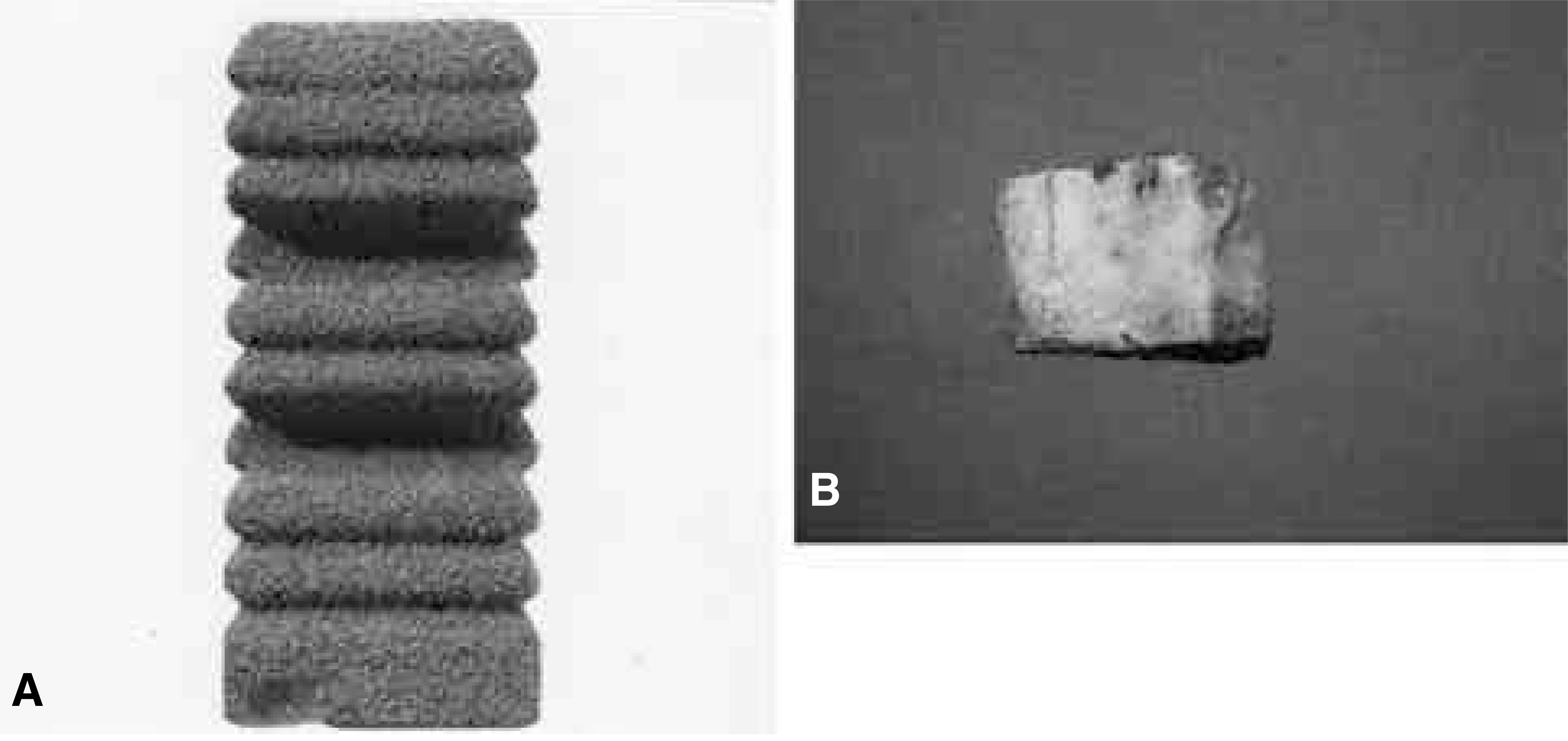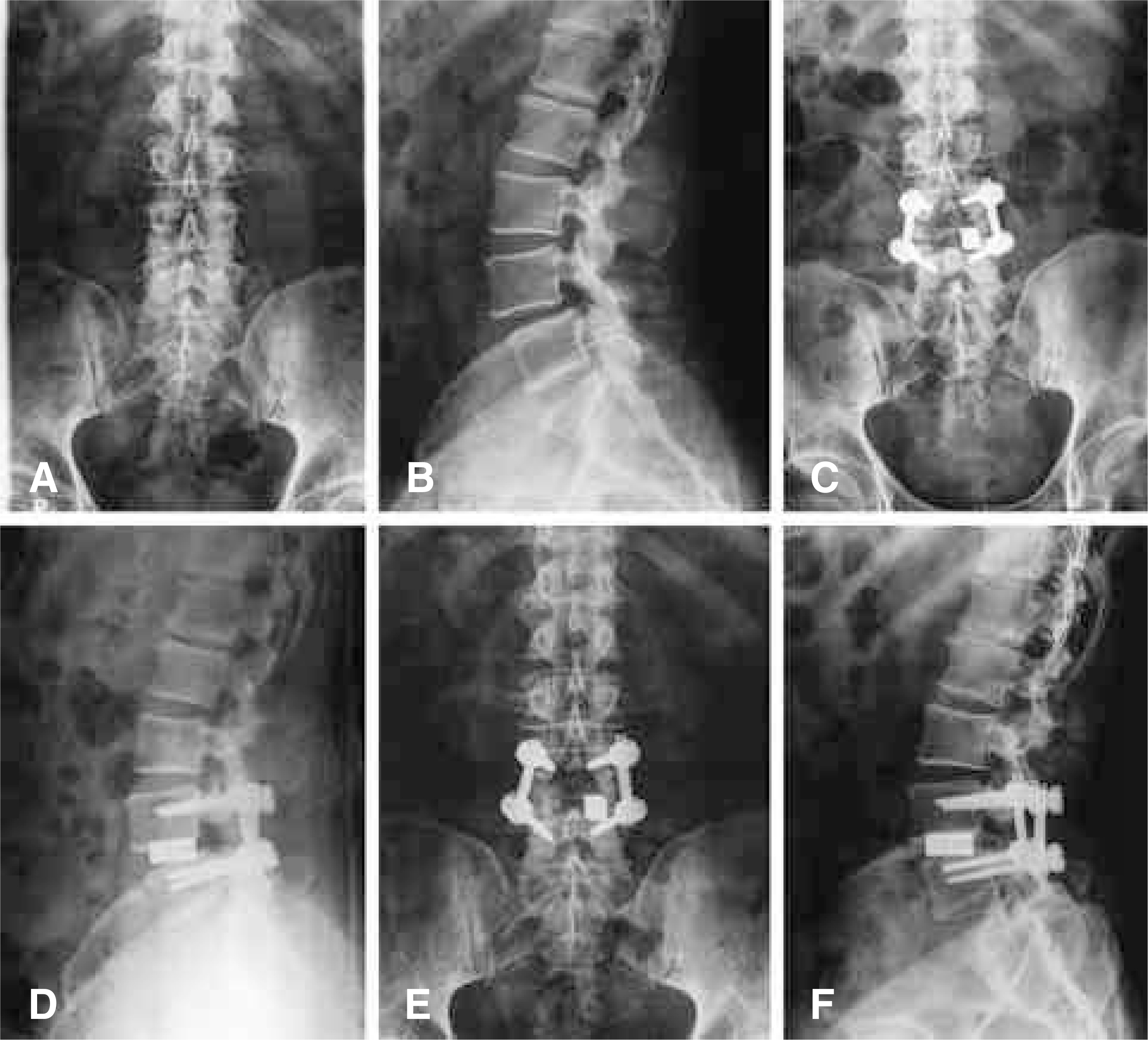J Korean Soc Spine Surg.
2005 Mar;12(1):52-57. 10.4184/jkss.2005.12.1.52.
Posterior Lumbar Interbody Fusion Using Laminar Bone and Titanium Block
- Affiliations
-
- 1Department of Orthopaedic Surgery, Chungju St. Mary's Hospital, Chungju, Korea. sangbume@hitel.net
- KMID: 1897021
- DOI: http://doi.org/10.4184/jkss.2005.12.1.52
Abstract
- STUDY DESIGN: A retrospective study to analyze the results of posterior lumbar interbody fusion, using laminar bone and titanium block, with pedicle screw instrumentation.
OBJECTIVES
To evaluate the clinical and radiological results of posterior lumbar interbody fusion, using laminar bone and titanium block, with pedicle screw instrumentation. SUMMARY OF LITERATURE REVIEW: Several studies have demonstrated the results of posterior lumbar interbody fusion, there has been no report on our method.
MATERIALS AND METHODS
From March 2001 to May 2002, seventeen patients were treated by posterior lumbar interbody fusion, using laminar bone block, from spinous process and titanium block. All patients were clinically followed up over 12 months. The mean age of the patients and follow-up were 58 years and 15 months, respectively. The clinical results were evaluated by Kim's criteria and radiological union, and the subsidence of disc space and change of the lordotic curve were assessed by a simple Xray.
RESULTS
The satisfactory clinical result and radiological union rates were 83.3 and 90.4%, respectively. The mean subsidence of the disc space and change of the lordotic curve were 0.8 mm and 1.6 degrees, respectively. There was one complication of a wrong insertion of the pedicle screw to the disc space.
CONCLUSION
Posterior lumbar interbody fusion using laminar bone and titanium block showed an acceptable radiological union rate and clinical results. This could be a good alternative method for obtaining initial stability and bony union without taking a bone graft from the posterior ilium in various spinal lesions.
Keyword
Figure
Reference
-
1). Cloward RB. Posterior lumbar interbody fusion updated. Clin Orthop. 1985; 193:16–19.
Article2). Lin PM. Posterior lumbar interbody fusion: Complication and fitfalls. Clin Orthop. 1985; 193:90–102.3). Brantigan JW, Steffee AD, Geiger JM. A carbon fiber implant to aid interbody fusion. Mechanical testing. Spine. 16(6 Suppl):S277–285. 1991.4). Ma GW. Posterior lumbar interbody fusionwith special -ized instruments. Clin Orthop. 1985; 193:57–63.5). Wetzel FT, LaRocca H. The failed posterior lumbar interbody fusion. Spine. 1991; 16:839–845.
Article6). Enker P, Steffee AD. Interbody fusion and instrumentation. Clin Orthop. 1994; 300:90–101.
Article7). Verlooy J, De Smedt K, Selosse P. Failure of a modified posterior lumbar interbody fusion technique to produce adequate pain relief in isthmic spondylolytic grade I spondylolisthesis patients. Spine. 1993; 18:1491–1495.8). Shin BJ, Kim KJ, Kwon H, Seo YS, Kim YI, Na SK. Results of PLIF using laminar chips in spinal lesions. J Korean Spine Surg. 1998; 2:284–292.9). Takeda M. Experience in posterior lumbar interbody fusion: Unicortical versus bicortical autologous grafts. Clin Orthop. 1985; 193:120–126.10). Schlegel KF, Pon A. The biomechanics of posterior lumbar interbody fusion (PLIF) in spondylolisthesis. Clin Orthop. 1985; 193:115–119.
Article11). Shin BJ, Kim KJ, Ha SS, Jung SH, Kwon H, Kim YI. Posterior lumbar interbody fusion using laminar bone block, J Korean Spine Surg. 1999; 6:110–116.12). Kim SS, Denis F, Lonstein JE, Winter RB. Factors affecting fusion rate in adult spondylolisthesis. Spine. 1990; 15:979–984.
Article13). Hutter CG. Posterior intervertebral fusion. A 25-year study. Clin Orthop. 1983; 179:86–96.14). Lin PM, Cautilli RA, Joyce MF. Posterior lumbar interbody fusion. Clin Orthop. 1985; 193:57–63.
Article15). Simmons JW. Posterior lumbar interbody fusion with posterior elements as chip graft. Clin Orthop. 1985; 193:85–89.16). Evans JH. Biomechanics of lumbar fusion. Clin Orthop. 1985; 193:38–46.
Article17). Lee CK, Langrana NA. Lumbosacral spinal fusion: A biomechanical study. Spine. 1984; 9:574–581.
Article18). Loguidice VA, Johnson RG, Guyer RD, Stith WJ, Ohnmeiss DD. Anterior lumbar interbody fusion. Spine. 1988; 13:336–369.
Article19). Denis S, Watkins R, Landaker S, Dillin W, Springer D. Comparison of disc space heights after anterior lumbar interbody fusion. Spine. 1988; 14:876–878.
Article20). Nasca RJ, Montgomery RD, Moeini SM, Lemons JE. Intervertebral spacer as an adjunct to anterior lumbar fusion. J Spinal Disord. 1988; 11:136–141.
- Full Text Links
- Actions
-
Cited
- CITED
-
- Close
- Share
- Similar articles
-
- Posterior Lumbar Interbody Fusion using Laminar Bone Block
- Evaluation of Posterior Lumbar Interbody Fusion
- Surgical Results according to the Interbody Fusion Methods in 360 degree Fusion for the Degenerative Lumbar Diseases
- Oblique Posterior Interbody Fusion with Bone Plugs by Unilateral Approach for Treatment of Lumbar Instability: Technical Note
- The results of the Posterior Lumbar Interboby Fusion using Titanium mesh cage for Spondylolisthesis



